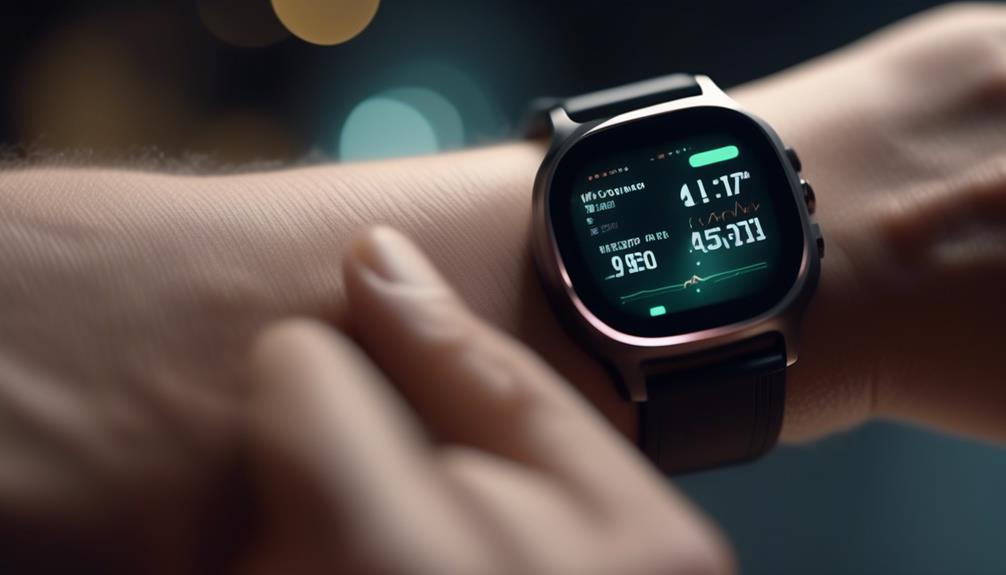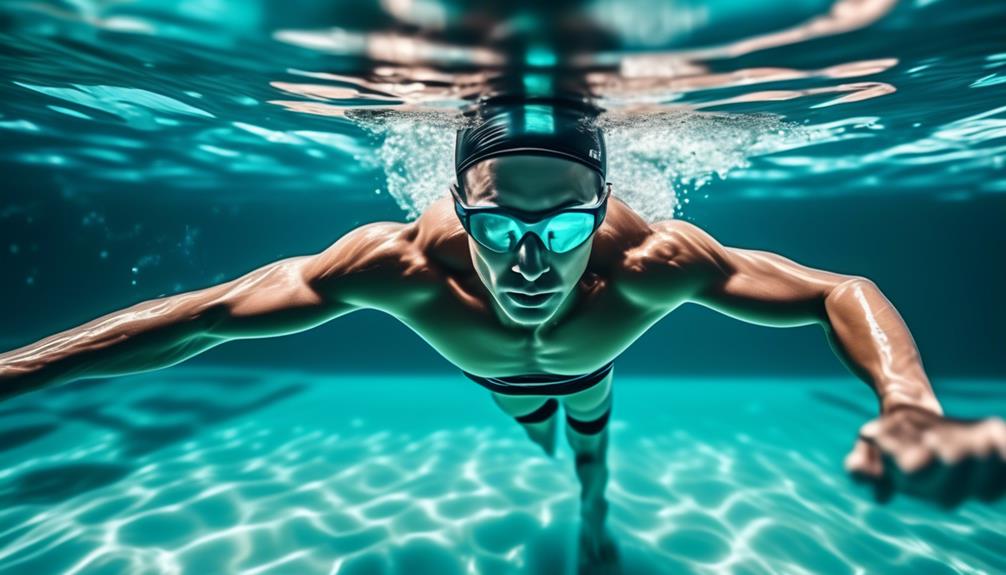They say that the heart is a window to the soul, but how do smartwatches accurately measure your heart rate? Well, let’s take a closer look.
Smartwatches typically measure heart rate accuracy through the use of optical sensors that emit and detect light to track blood flow. The light reflects off of the blood vessels and the sensor measures the changes in light absorption, which can indicate heart rate.
Some smartwatches also incorporate additional sensors, such as accelerometers, to improve the accuracy of heart rate measurements. However, it is important to note that while smartwatches can provide a convenient way to monitor heart rate, they may not always be as accurate as medical-grade devices.
Smartwatches utilize advanced technology, such as photoplethysmography (PPG), to measure your heart rate. PPG technology uses light sensors to detect changes in blood flow through your skin, allowing it to calculate your heart rate.
But here’s the thing – the accuracy of these measurements can vary depending on the device you’re using and the activity you’re engaged in. So, if you want to know just how reliable your smartwatch’s heart rate monitoring feature is, keep reading.
There’s more to uncover.
Key Takeaways
- Smartwatches use photoplethysmography (PPG) technology to accurately measure heart rate.
- Optical sensors and PPG technology detect changes in blood flow through the skin to calculate heart rate.
- Apple and Samsung devices have shown high accuracy in measuring baseline heart rate and during episodes of rapid heart rate.
- Factors such as user movement during physical activities can affect heart rate accuracy, but advancements in sensor technology have improved reliability.
Understanding Heart Rate Monitoring Technology
To understand heart rate monitoring technology, it’s crucial to examine the use of photoplethysmography (PPG) technology, which detects changes in blood flow through the skin using specialized sensors in smartwatches. PPG technology works by emitting light into the skin and measuring the amount of light that’s reflected back. When blood flows through the vessels, it absorbs more light, resulting in a decrease in the amount of light reflected back. By analyzing these changes in light reflection, smartwatches can accurately measure heart rate.
Wearable devices, such as smartwatches, have become increasingly popular for tracking heart rate due to their convenience and accessibility. Many studies have evaluated the accuracy of heart rate measurements in smartwatches, including Apple Watch, Samsung Galaxy Gear, and Fitbit Charge. These studies have assessed heart rate accuracy during various activities, including episodes of rapid heart rate like PSVT.
The findings have shown that both Apple and Samsung smartwatches exhibit higher accuracy in measuring heart rate compared to Fitbit. However, it’s important to note that the accuracy of heart rate monitoring may vary for different activities. For instance, walking and typing activities may yield different results compared to rest or exercise.
Despite these challenges, smartwatches like Apple, Samsung, and Garmin have been found to provide accurate and reliable heart rate monitoring. This technology offers valuable insights into heart health during different activities, empowering individuals to take control of their well-being.
Optical Sensors and Photoplethysmography (PPG)
Optical sensors and photoplethysmography (PPG) are crucial components of smartwatches that accurately measure heart rate by detecting changes in blood flow through the skin. By using PPG technology, smartwatches with optical sensors, like Apple Watch and Fitbit Charge, can provide precise heart rate measurements.
These sensors enable accurate heart rate monitoring during different activities and even during episodes of rapid heart rate, ensuring reliable heart rate measurement for users.
Accuracy of Optical Sensors
The accuracy of heart rate measurements using optical sensors, specifically photoplethysmography (PPG), in smartwatches has been extensively tested and proven to be highly reliable.
Studies have evaluated the accuracy of various smartwatches, including the Apple Watch Series 2, Samsung Galaxy Gear S3, and Fitbit Charge 2, in measuring both baseline heart rate and heart rate during episodes of paroxysmal supraventricular tachycardia (PSVT).
Results have shown that Apple and Samsung devices achieved 100% accuracy in detecting baseline heart rate within five beats per minute (bpm), while Fitbit had a slightly lower accuracy of 94%.
During PSVT episodes, Apple and Samsung devices maintained 100% accuracy within 10 bpm, while Fitbit had an accuracy of 88%.
These findings suggest that wearable devices with optical sensors are effective in accurately measuring heart rate, regardless of age, sex, or type of PSVT.
Functionality of PPG
Using photoplethysmography (PPG) and optical sensors, smartwatches and wrist-worn fitness trackers accurately measure heart rate by detecting changes in blood flow through the skin. PPG works by shining a light onto the skin and measuring the amount of light that’s absorbed, reflected, or transmitted. As the heart beats, blood flow through the skin changes, causing variations in the amount of light detected. These changes are then used to calculate the heart rate.
Numerous studies have shown that smartwatches equipped with PPG technology provide accurate heart rate measurements across different skin tones and during various activities. They’ve also demonstrated high accuracy in measuring baseline heart rate and heart rate during arrhythmic situations. This functionality of PPG makes smartwatches a reliable and convenient tool for monitoring heart rate accuracy.
Smartwatch Heart Rate Measurement
Smartwatches and wrist-worn fitness trackers accurately measure heart rate by utilizing photoplethysmography (PPG) and optical sensors. These devices have been evaluated for their accuracy in measuring heart rates, including during episodes of rapid heart rate like paroxysmal supraventricular tachycardia (PSVT). Studies have shown that these devices can accurately measure baseline heart rates within a range and during PSVT episodes, with an accuracy ranging from 88% to 100%.
The accuracy may vary based on the type of pacing. Furthermore, smartwatches and wrist-worn fitness trackers have been found to estimate heart rate accurately across different skin tones and during various activities.
It’s important to note that while these devices provide convenient and accessible heart rate measurements, they may not be as accurate as gold-standard methods like electrocardiogram (ECG). However, they still offer valuable information for individuals who desire freedom and flexibility in monitoring their heart rate.
Factors Affecting Heart Rate Accuracy
When considering factors that can affect the accuracy of heart rate measurements on smartwatches, it’s important to note advancements in sensor technology and potential interference from user movement.
Sensor technology plays a crucial role in capturing accurate heart rate data, and advancements in this area can greatly improve the reliability of measurements.
Additionally, user movement during physical activities can introduce noise and artifacts that may impact the accuracy of heart rate readings.
Understanding and addressing these factors is essential for ensuring the accuracy and effectiveness of heart rate monitoring on smartwatches.
Sensor Technology Advancements
Sensor technology advancements have played a crucial role in improving the accuracy of heart rate measurements in smartwatches and wrist-worn fitness trackers. These advancements have allowed for more precise and reliable monitoring of heart rate, providing users with valuable information about their cardiovascular health.
Here are three ways in which sensor technology advancements have contributed to heart rate accuracy in wearable devices:
- Specialized sensors: Smartwatches and fitness trackers now come equipped with specialized sensors that can measure changes in blood flow through the skin. This technology enables the devices to estimate heart rate accurately, even during different activities.
- Consistency across skin tones: Studies have shown that heart rate accuracy doesn’t significantly differ among individuals with light, medium, or dark skin tones. This indicates that sensor technology advancements have made heart rate measurements reliable across various skin tones.
- 24-hour monitoring: Wearable devices like the Apple Watch 3 and Fitbit Charge 2 can provide acceptable heart rate accuracy throughout a 24-hour period. This makes them useful for ambulatory measurement of cardiac activity in research studies, providing researchers with valuable data.
Thanks to sensor technology advancements, heart rate accuracy in wearable devices has significantly improved, allowing users to monitor their cardiovascular health more effectively.
User Movement Interference
User movement interference can significantly impact the accuracy of heart rate measurements in smartwatches and wrist-worn fitness trackers. Factors such as vigorous physical activity, wrist movements, and poor device fit can all contribute to inaccuracies in heart rate readings. During exercise or high-intensity activities, user movement interference can lead to unreliable data.
However, advancements in sensor technology and algorithms have enabled smartwatches to minimize the impact of user movement interference on heart rate accuracy. It’s important to ensure that the smartwatch is properly positioned and snugly worn on the wrist to mitigate any potential interference.
Algorithms and Data Processing
Algorithms and data processing are integral elements in ensuring the accuracy of heart rate measurements on smartwatches. These wearable devices rely on complex computations and algorithms to interpret raw sensor data and provide accurate heart rate readings.
Here are three key aspects of algorithms and data processing that contribute to the accuracy of heart rate measurements on smartwatches:
- Processing Raw Sensor Data: Smartwatches use algorithms to process the raw data captured by sensors like photoplethysmography (PPG). These algorithms employ techniques such as signal filtering, noise reduction, and pattern recognition to extract meaningful information about heart rate from the raw sensor data.
- Translating Blood Flow Changes: Data processing algorithms in smartwatches analyze PPG signals to detect changes in blood flow. These changes are then translated into heart rate measurements through mathematical calculations and statistical methods, ensuring precision in capturing fluctuations in heart rate during different activities and physiological conditions.
- Continuous Refinement and Optimization: The accuracy of heart rate measurements on smartwatches heavily relies on the continuous refinement and optimization of data processing algorithms. Factors like motion artifacts, skin tone variations, and diverse user activities need to be considered and addressed in algorithm development to improve accuracy.
Comparative Analysis of Smartwatch Brands
The comparative analysis of different smartwatch brands reveals the accuracy of their heart rate measurements and highlights the potential insights into heart health provided by these wearable devices.
In a study that validated the accuracy of wrist-worn wearable devices, including Apple Watch Series 2, Samsung Galaxy Gear S3, and Fitbit Charge 2, it was found that these devices were able to accurately measure PSVT (Paroxysmal Supraventricular Tachycardia).
Furthermore, the study assessed the accuracy of Apple, Samsung, and Fitbit in detecting baseline heart rate within five bpm, with both Apple and Samsung showing 100% accuracy in this regard.
Another comparison was made between the accuracy of Apple Watch 3 and Fitbit Charge 2 in measuring heart rate, and it was found that both devices provided acceptable accuracy across the 24-hour period.
However, the study also highlighted some challenges that limit progress in achieving accurate heart rate monitoring with wearable devices, such as issues with comparison methods, firmware updates, and real-world conditions.
Despite these challenges, the importance of heart rate monitoring in smartwatches can’t be underestimated, as accurate heart rate tracking can provide valuable insights into heart health.
Improving Heart Rate Accuracy in Smartwatches
Can Heart Rate Accuracy in Smartwatches Be Enhanced?
Improving heart rate accuracy in smartwatches is a goal that many manufacturers are working towards. By implementing certain strategies and technologies, it’s possible to enhance the accuracy of heart rate measurements in these devices.
Here are three ways that heart rate accuracy in smartwatches can be improved:
- Advanced sensor technology: Smartwatches can benefit from the use of advanced sensor technology to capture heart rate data more accurately. By incorporating sensors that are more sensitive and capable of detecting subtle changes in heart rate, smartwatches can provide more precise measurements.
- Machine learning algorithms: By utilizing machine learning algorithms, smartwatches can continuously learn and adapt to individual users’ unique physiological characteristics. This can help improve the accuracy of heart rate measurements by taking into account factors such as skin tone, activity level, and other personal variables.
- Regular firmware updates: Manufacturers should consistently release firmware updates for their smartwatches to address any issues or limitations that may affect heart rate accuracy. By staying up to date with the latest firmware, users can ensure that their smartwatches are performing optimally and providing accurate heart rate measurements.
Frequently Asked Questions
How Accurate Is Heart Rate on Smartwatches?
Heart rate accuracy on smartwatches varies due to factors like skin tone and activity level. Different smartwatches, like Apple, Samsung, and Garmin, provide accurate heart rate tracking, each with unique data presentation and features. Accuracy is crucial for fitness tracking devices.
How Does Smart Watch Analyze Heart Rate?
Smartwatches analyze heart rate using optical sensor technology, which measures blood flow through the skin. They then apply machine learning algorithms to perform heart rate variability analysis, providing accurate and precise results.
Are Wearable Devices Accurate for Heart Rate?
Wearable devices, like smartwatches, can accurately measure heart rate. Factors such as fitness tracking features and heart rate variability can affect accuracy. It’s important to consider these factors when evaluating the accuracy of wearable devices.
Which Smart Watch Is Most Accurate for Heart Rate?
The most accurate smartwatch for heart rate monitoring technology varies among brands. Comparing heart rate accuracy, Apple and Samsung showed 100% accuracy, while Fitbit had 88% accuracy within 10 bpm.
Conclusion
In conclusion, smartwatches have revolutionized the way we monitor our heart rate. Through the use of optical sensors and PPG technology, these devices accurately measure changes in blood flow to calculate heart rate.
While the accuracy can vary depending on the activity being performed, studies have shown that smartwatches are effective in estimating heart rate in individuals with different skin tones.
With further advancements in algorithms and data processing, smartwatches continue to improve their accuracy, making them valuable tools for tracking heart health.





